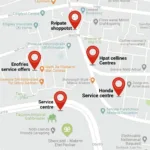Taking your Honda for service ensures it runs smoothly for years to come. But navigating the dealership experience can feel overwhelming. This guide provides a clear roadmap on how to best take your Honda car to the service dealership, ensuring a smooth and stress-free experience.
Understanding Your Honda’s Service Needs
Before heading to the dealership, take time to understand your Honda’s specific needs. Check your owner’s manual for the recommended service schedule based on mileage or time elapsed since your last service. Knowing what services are due helps you understand the scope of work and anticipated costs.
Scheduling Your Honda Service Appointment
Most dealerships offer various booking methods to fit your schedule.
- Online Booking: Many dealerships provide online service scheduling through their websites. This convenient option lets you choose a date and time that works best for you.
- Phone Call: You can always call the service department directly. Speaking with a service advisor allows you to ask questions and confirm appointment details.
- Dealership Visit: While less common, you can visit the dealership in person to schedule an appointment. This allows you to meet the service team and see the facility firsthand.
When scheduling, clearly communicate the services needed, any specific concerns, and your preferred contact method for updates.
Preparing Your Honda for Service
Before dropping off your car, take a few steps to prepare:
- Clean Out Personal Items: Remove valuables and unnecessary items from your vehicle.
- Note Existing Damage: If there’s any pre-existing damage, note it before arriving at the dealership.
- Gather Relevant Documents: Bring your owner’s manual, service history, and any warranty information.
What to Expect at the Dealership
Upon arrival, a service advisor will greet you and review your appointment details. They’ll ask about any issues you’re experiencing and answer any questions you may have. You can expect:
- Thorough Vehicle Inspection: A technician will inspect your Honda, looking for signs of wear and tear or potential problems.
- Service Recommendations: The advisor will present you with a service plan based on your car’s needs and the manufacturer’s recommendations.
- Cost Estimate: You’ll receive a detailed estimate of the cost of service, including parts and labor.
- Waiting Area Amenities: While your car is being serviced, most dealerships offer comfortable waiting areas with Wi-Fi, refreshments, and sometimes even workspaces.
Understanding Service Costs
Don’t be afraid to ask for clarification on any aspect of the service costs. This includes understanding:
- Labor Rates: Inquire about the dealership’s hourly labor rate.
- Parts Costs: Ask about the cost of individual parts, especially if you’re comparing prices from different sources.
- Warranty Coverage: Clarify what’s covered under your warranty.
Communicating Effectively with the Service Advisor
Clear communication ensures you receive the best possible service:
- Be Specific: Clearly describe any problems you’re experiencing, including noises, smells, or warning lights.
- Ask Questions: Don’t hesitate to ask questions about the service recommendations or costs.
- Express Your Budget: If you have budget constraints, communicate them openly.
- Stay Informed: Request updates on the progress of your service.
“Transparency is key to building trust with customers,” says John Smith, Senior Service Advisor at Honda City Center. “We encourage our clients to ask questions and understand each service their vehicle needs.”
Picking Up Your Honda
When your car is ready, the service advisor will contact you. Before leaving the dealership:
- Review the Invoice: Carefully review the invoice, ensuring all charges are accurate.
- Ask About Completed Work: Ask the advisor to explain the work completed on your car.
- Keep Service Records: Retain all service records for warranty purposes and future reference.
When Should You Take Your Honda to an Independent Mechanic?
While dealerships offer specialized knowledge and genuine parts, you might consider an independent mechanic for:
- Routine Maintenance: Independent mechanics often offer competitive rates on routine services like oil changes and tire rotations.
- Out-of-Warranty Repairs: If your Honda is no longer under warranty, an independent mechanic might provide more affordable repair options.
However, if you need complex repairs or specialized work, a dealership is often the best choice.
Want to know more about when you should get your car serviced? Check out our comprehensive guide.
Conclusion
Taking your Honda to the service dealership doesn’t have to be stressful. By understanding your car’s needs, communicating effectively with the service team, and following these tips, you can ensure a smoother experience and keep your Honda running its best for miles to come.
Need assistance finding reliable Honda service in Kerala? Explore our detailed guide on how to know the service history of Honda cars in Kerala for valuable insights.
For any concerns or complaints regarding your Honda car service, we have resources available to help. Learn more about where to complain about Honda car service and ensure your voice is heard.
